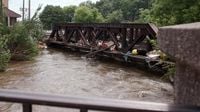When historic floods swept through southeastern Wisconsin in early August 2025, the devastation was swift and widespread. Record rainfall—peaking at 14 inches in northwest Milwaukee and averaging six inches citywide—overwhelmed stormwater systems, inundated homes, and left entire neighborhoods facing ruin. By the time the waters receded, more than 1,500 residential structures were destroyed or severely damaged, and damages across six counties soared past $76 million, according to estimates from Governor Tony Evers’ administration and the Milwaukee Metropolitan Sewerage District (as reported by Civic Media and The Blueprint).
On September 12, 2025, U.S. President Donald Trump announced that he had partially approved Governor Evers’ request for federal disaster aid, promising $29.8 million to help Wisconsin recover. “We had Huge Victories in Wisconsin in 2016, 2020 and 2024, and it is my Honor to deliver BIG for Wisconsinites!” Trump wrote in a social media post, as cited by The Blueprint. The president’s announcement followed weeks of mounting pressure from both state and federal officials, who had urged the Federal Emergency Management Agency (FEMA) to assess the scale of the destruction and expedite relief.
Governor Evers’ original request sought disaster relief for six counties: Milwaukee, Washington, Waukesha, Door, Grant, and Ozaukee. Ultimately, the Trump administration approved federal aid for just three—Milwaukee, Washington, and Waukesha—leaving decisions for Door, Grant, and Ozaukee counties pending. “Over the past month, my administration and I have been working hard to ensure the folks and families whose homes, businesses, schools, and community centers were impacted have the support they need to recover,” Evers said in a statement reported by Civic Media. He added, “I want to again thank the volunteers, organizations, and communities who are helping our neighbors, friends, and families recover, but our work is not done. I will continue to urge the Trump Administration to approve the remainder of my request, and I will keep fighting to make sure Wisconsin receives every resource that is needed and available.”
The partial approval did not go unnoticed among Wisconsin’s political leaders, who—despite their differences—found common cause in pushing for federal support. U.S. Senator Tammy Baldwin underscored the urgency, saying, “I have been fighting for these funds because Wisconsinites need help and they need it now.” Senator Ron Johnson, meanwhile, offered a more effusive response: “Thank you to President Trump for continuing to deliver BIG TIME for Wisconsinites.” Representative Bryan Steil (R – 1st District) called the announcement “great news for working families in Wisconsin,” while Representative Gwen Moore (D – 4th District) said, “I am thrilled that Governor Evers’ disaster declaration request was approved.” Representative Scott Fitzgerald (R – 5th District) emphasized that the decision “will bring much-needed resources to help communities recover,” and Representative Glenn Grothman (R – 6th District) thanked Trump directly for “standing with Wisconsin as we work to recover from the devastating floods.”
The bipartisan push extended beyond statements. In August, Wisconsin’s congressional delegation endorsed a letter to the U.S. Department of Homeland Security, urging FEMA to work with state emergency personnel to evaluate the damage and accelerate aid. Teams from the Milwaukee County Office of Emergency Management and FEMA conducted on-the-ground surveys throughout the month, documenting the scale of the destruction in neighborhoods and public infrastructure alike, according to The Blueprint.
Local officials in Milwaukee, one of the hardest-hit areas, welcomed the president’s decision. Milwaukee Mayor Cavalier Johnson stated, “The President’s social media post is welcome news for the people who have suffered in August’s flooding. The damage was extensive and federal help is so important as our residents get their lives back on track.” He credited the collaborative efforts of city, county, state, and FEMA officials for moving the process forward. Milwaukee County Executive David Crowley echoed the sentiment: “My administration and I have been working across all levels of government to get our residents and families the resources they need following last month’s extreme flooding.”
Despite this progress, the story of Wisconsin’s disaster relief is also one of delays and partial answers. As reported by the Associated Press, President Trump’s administration has taken longer on average to approve disaster aid requests than previous administrations—a trend not unique to any one party. An AP analysis revealed that, while requests in the 1990s and early 2000s were typically granted within two weeks, the average wait time has stretched to about three weeks over the past decade. During Trump’s first term, that average was 24 days. For Wisconsin, the wait was relatively short—just 15 days from Governor Evers’ request to the president’s approval. Still, the partial approval left some communities in limbo, uncertain whether they would receive federal reimbursement for cleaning up debris and rebuilding infrastructure.
White House spokeswoman Abigail Jackson told the Associated Press that Trump’s administration is providing “a more thorough review of disaster declaration requests than any Administration has before him” to ensure that federal tax dollars are spent wisely. But those thorough reviews can mean individuals and local governments must wait longer for aid—delays that can hamper recovery efforts and leave families without support for daily living expenses, temporary lodging, or home repairs.
Wisconsin’s experience is part of a broader pattern in 2025. On September 11, President Trump approved federal disaster relief not just for Wisconsin, but for six states and tribal nations following storms and floods over the spring and summer. The same day, North Dakota received federal disaster relief funds for communities battered by June storms that included tornadoes, large hail, and straight-line winds—though, as reported by the North Dakota Monitor, that approval came 52 days after Governor Kelly Armstrong’s request. In North Dakota, federal aid is expected to total about $16 million, with the state contributing an additional $2.5 million. A separate request for August storms remains under review there.
In Wisconsin, the $29.8 million in federal aid will be directed primarily toward Milwaukee, Washington, and Waukesha counties. All six counties originally included in Evers’ request will receive some money from their local governments to address infrastructure repairs, but the fate of federal funding for Door, Grant, and Ozaukee counties remains uncertain as of this writing.
As communities across southeastern Wisconsin begin the long process of rebuilding, the need for continued advocacy and support remains clear. The partial federal aid offers a lifeline, but for many families and local governments still grappling with the aftermath of August’s historic floods, the road to full recovery is far from over.


